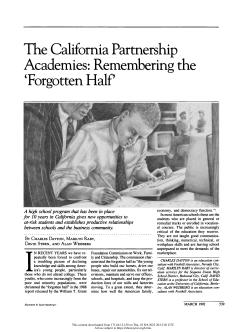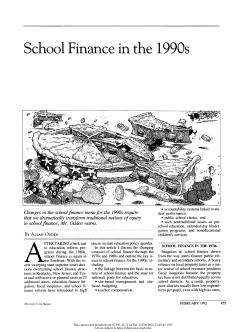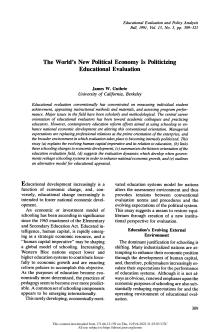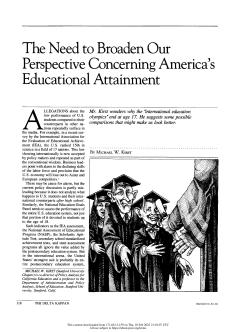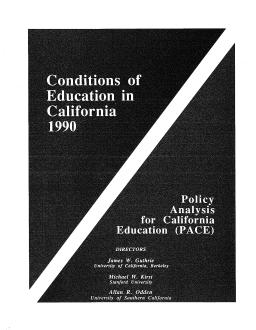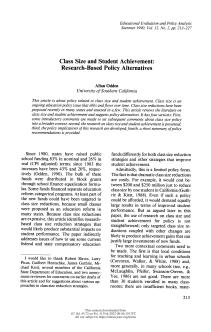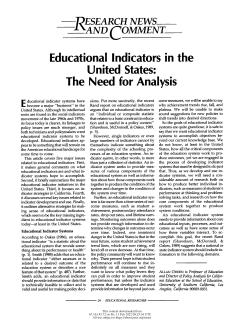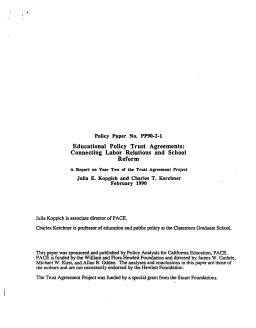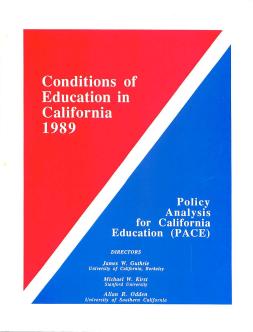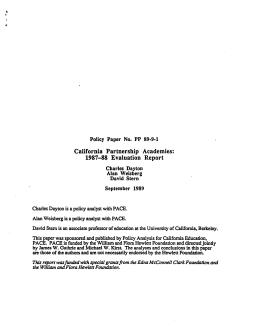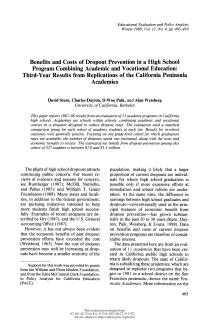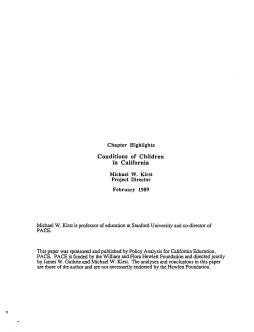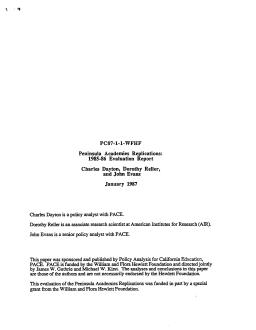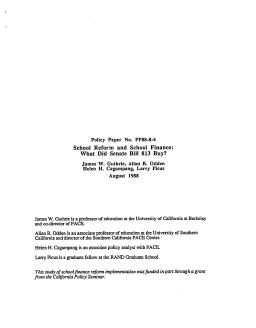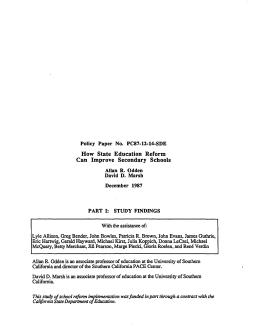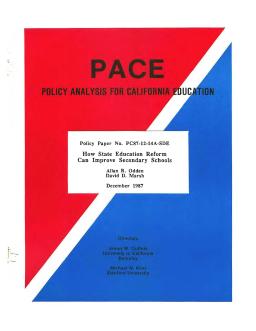Published
Summary
The seventh edition of Conditions of Education in California by PACE focuses on education policy issues in a national context. The report analyzes California's education data by placing it in multi-state, national, and international contexts. The report's first three chapters analyze evolving education policy issues, Sacramento political dynamics, and student achievement. The remaining three chapters provide longitudinal data on student enrollment, finance, and system characteristics. The report aims to provide a continuing picture of education in California.
Remembering the "Forgotten Half"
Published
Summary
US high school students, especially those who do not attend college, have been found to lack skills and knowledge necessary for the job market. The California Partnership Academies program has been developed to address this issue and has been adopted by over 50 high schools. The program has received support and positive evaluations. Factors contributing to the issue include societal changes, the education system, and changes in the labor market. If these issues are not addressed, the US risks falling behind international competitors and a lower standard of living.
Published
Summary
School finance has become a prominent issue again due to court decisions and litigation in several states. This article explores school finance changes in the 70s and 80s and outlines key issues for the 90s, including the relationship between finance and education goals, site-based management, teacher pay, accountability, school choice, and nontraditional issues such as preschool and non-educational services for children.
Published
Summary
Traditionally, educational evaluation has focused on measuring student achievement and program performance. However, education reforms are now linking schooling to economic development, leading to a shift towards managerial expectations and politicization of the field. This article explains the human capital imperative and its relation to education, summarizes the history of educational evaluation, and outlines an alternative model for educational appraisal in the context of government-led education system reforms aimed at enhancing national economic growth.
Published
Summary
The U.S. ranks low in international education comparisons, but the discussion is misleading because it does not look at postsecondary education. The value added by the postsecondary education system, including community colleges, trade schools, and universities, is ignored. The U.S.'s strongest suit is probably its entire postsecondary education system in the international arena.
Published
Summary
CA's education system is affected by external factors like shifting demographics, declining economics, and intensifying politics, limiting the traditional routes of local decision-making and property taxation. Although some districts show excellence and commitment, creating and sustaining a statewide education system to meet 21st-century expectations is difficult without a comprehensive reform plan. Political conflict over revenue earmarking and school reform distracts from education improvement. This report describes and analyzes these issues, suggesting a comprehensive set of solutions.
Research-Based Policy Alternatives
Published
Summary
This article delves into the issue of class size in education, examining how it affects student achievement and suggesting policy alternatives. With some states proposing and implementing class size reductions, the analysis discusses the research on the subject and its policy implications. The piece is divided into four sections, starting with an introduction that provides context for the class size debate.
The Need for Analysis
Published
Summary
Educational indicator systems are in demand in the US due to their strong linkages to policy issues. This article covers five major issues related to educational indicators, including what they are, major initiatives in the US, and indicator strategies in California. It also discusses key issues related to indicator development and use and outlines alternative strategies for making sense of educational indicators, which are currently missing in the US.
Connecting Labor Relations and School Reform: A Report on Year Two of the Trust Agreement Project
Published
Summary
The Trust Agreement Project, initiated in September 1987, is a joint effort of 12 California school districts and their teachers' unions. It enables teachers and school management to develop agreements on professional issues beyond the traditional scope of collective bargaining. The agreements cover topics like teacher evaluation and curriculum development, and aim to enhance educational capacity by promoting collective responsibility for educational processes and outcomes. The project appears to be altering decision-making processes and encouraging collaboration between unions and management.
Published
Summary
The study examines the Partnership Academies in California, which are designed to reduce high school dropout rates among at-risk students. Academies combine high school curriculum, technical courses, and support from local businesses, with funding based on student outcomes. Survey results indicate that Academy students had a lower dropout rate than comparison group students, were more likely to attend college, and earned higher wages while working and studying. Graduates from both groups reported being fairly satisfied with their high school preparation and achievements since graduation.
Published
Summary
This is the fifth edition of Conditions of Education in California. Over time, the content and format have changed in keeping with suggestions made by readers. This publication is based upon compilations and syntheses of information collected by other agencies and individuals. These sources are noted throughout the text. We wish here to express our appreciation to these others upon whose efforts we depend so heavily. Also, PACE undertakes a substantial amount of original data collection and analysis. We make specific mention of this throughout the text.
1987–88 Evaluation Report
Published
Summary
This report presents findings from the third annual evaluation of Partnership Academy Programs in CA, a high school-based, state-funded program with a school-within-a-school administrative structure that enrolls at-risk students with academic potential. The program provides students with basic job skills in a promising labor-market field and support from local businesses, including curriculum development, guest speakers, field trips, mentors, and work experience positions. The evaluation addresses the quality of program implementation and the degree to which programs follow the academy model.
A Hypothetical Account and Research Review
Published
Summary
This paper discusses childcare quality and its impact on child development. It highlights the need to consider various factors that contribute to quality and how they affect children's experiences. Presented is a hypothetical day in two different childcare situations to demonstrate the varying experiences children have. The characters and incidents are fictional but based on the author's real observations and experiences in early childhood programs in CA. The author emphasizes the need to promote quality early childhood programs informed by research in child development and early education.
Third-Year Results from Replications of the California Peninsula Academies
Published
Summary
Evaluation of 11 California high school academies in 1987-88 found positive in-school outcomes. Academies combine academic and vocational courses to reduce dropout rates. Graduation rates available for one grade-level cohort, with an estimated net benefit of $1.0-1.3 million from dropout prevention.
An Exploration of the Debate on School District Size
Published
Summary
The notion that larger school districts are superior has changed, with some researchers advocating for smaller ones. Recent reform reports have focused on the school site as the decision-making seat. Three main issues guide district size research: fiscal efficiency, school effectiveness, and community identity. Although research has been conducted, there is still no definitive answer. This article explores the research and debate on the "right" size for school districts and identifies unanswered questions, hoping to kindle interest in further research.
Published
Summary
California's growing child population will require significant increases in public spending, particularly in education due to immigration, working parents, poverty, and family disorganization. Counties and school districts bear the brunt of providing children's services, but cities have greater fiscal flexibility and revenue-raising potential. This paper provides information on county children's services and trends in county budgets to support further research on county financing for children's services.
Chapter Highlights
Published
Summary
This report provides social indicators to evaluate the quality of life for children in California, covering physical and mental health, safety, sexual behavior, academic achievement, and the settings and systems that serve children. Despite most children being healthier and better schooled than in the past, recent polls indicate concern about child-rearing and the likelihood of an expanding educational underclass. The report aims to offer a portrait of the quality of California's children, address gaps in available data, and provide limited policy recommendations.
Second-Year Results from Replications of the California Peninsula Academies
Published
Summary
This article discusses the results of replicating the California Peninsula Academies model in 10 high schools. The model provides technical instruction in an occupational field, alongside core academic curriculum, and is designed to prevent dropouts. Evidence suggests that Academy students performed better in terms of grades and course credits compared to students in comparison groups, particularly at three sites.
Graduate Follow-up Survey
Published
Summary
A survey was conducted on the first class of participants in the "Jobs for the Disadvantaged" program and a comparison group six months after graduation. Although the sample size was small, a significantly higher percentage of program participants graduated on time than the comparison group. About half of both groups were in postgraduate schooling, but more program graduates were working. Among those in school, few differences were found. For those working, twice as many program graduates secured work through school, but comparison-group graduates had somewhat higher wages.
1986–87 Evaluation Report
Published
Summary
In the fall of 1985, ten academy programs were established by the State of California as replications of the Peninsula Academies. PACE evaluated these 10 academies in 1985–86. This report presents findings from a second evaluation covering the academies' 1986–87 school year.
Program Successes and Evaluations Under 'Jobs for the Disadvantaged'
Published
Summary
This report discusses the challenges of implementing broad state-level initiatives to reform schools in California, following the passage of S.B. 813 in 1983. While earlier studies showed the formal implementation of these reforms, their impact on local schools and substantive changes remained unclear. The article uses data to answer the question of whether these state-level initiatives can improve local schools, concluding that successful implementation depends on several factors. The evaluations also revealed lessons about conducting evaluations and obtaining necessary data from schools.
Published
Summary
The fourth edition of Conditions of Education in California has expanded its content to include a special features section on education reform processes, along with the previously included sections. The publication is based on compiled information from other sources and original data collection and analysis. The format has been altered to improve readability for a wide range of audiences.
Study Findings
Published
Summary
In 1983, California's Senate Bill 813 aimed to improve the education system by proposing a large number of reforms. However, it lacked a cohesive strategy and proven philosophy. The bill's impact on school districts and schools was unknown, and this study aimed to assess whether selected schools could implement the reform components and whether they contributed to school improvement. The goal was to understand how schools reacted to state mandates and inducements for improvement.
A Preschool Through High School Concern
Published
Summary
This report explores why thousands of students continue to drop out despite the belief that education is necessary for success. By examining dropout characteristics and behavior from preschool through high school, it presents the experience of selected dropout prevention programs. Focusing on the specific act of dropping out may neglect earlier clues, so understanding students' experiences as they progress through grades is crucial for effective prevention strategies.
Background and Technical Appendices
Published
Summary
California's education system faced a decline in the early 1980s, prompting reforms such as a common core curriculum, higher graduation requirements, and tougher academic standards. A Nation at Risk report further pushed for nationwide school changes. California's swift response led to the enactment of Senate Bill 813, a comprehensive education reform program with over 80 policy and program reforms. Several studies showed positive results, but the study in this report aims to determine how state-level education reforms improved local schools.

